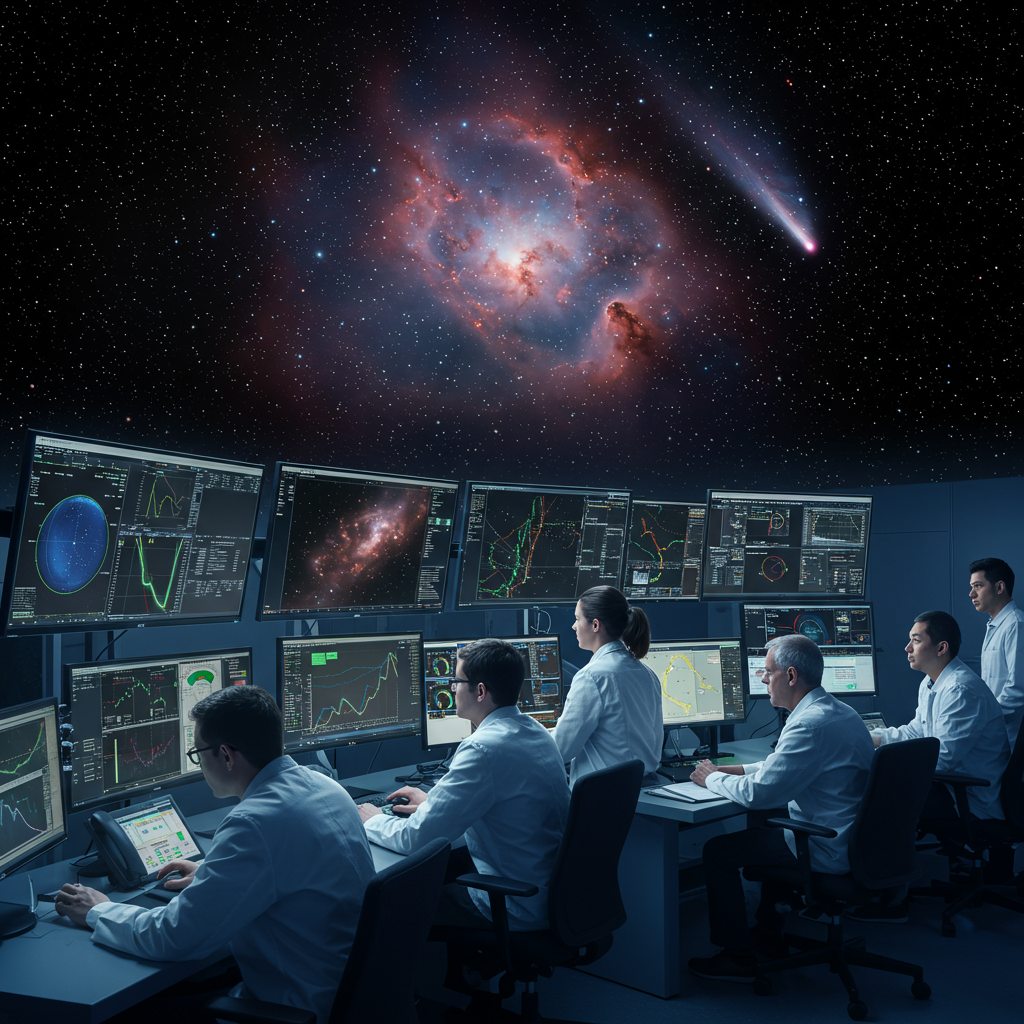Humanity is embarking on an unprecedented observational campaign, leveraging deep-space missions to study a rare visitor from beyond our solar system. The European Space Agency (ESA) is spearheading efforts to closely examine interstellar comet 3I/ATLAS (C/2025 N1), the third known object to journey into our cosmic neighborhood from another star system. This celestial wanderer presents a unique opportunity for scientists to unlock secrets about the early universe and planetary formation far beyond our Sun. Using its Mars orbiters and the Jupiter Icy Moons Explorer (Juice), ESA is set to capture unparalleled views as 3I/ATLAS races through the inner solar system in late 2025. These crucial observations will provide vital data on its composition and activity, offering a direct glimpse into a relic potentially billions of years old.
The Enigma of 3I/ATLAS: A Galactic Wanderer
Comet 3I/ATLAS first announced its presence on July 1, 2025. An Asteroid Terrestrial-impact Last Alert System (ATLAS) telescope in Río Hurtado, Chile, made the initial discovery. Its unusual hyperbolic trajectory immediately signaled an origin outside our solar system. This makes it only the third such object ever detected, following 1I/‘Oumuamua (2017) and 2I/Borisov (2019). Moving at an astonishing speed of roughly 210,000 km/h (130,000 mph), 3I/ATLAS is the fastest solar system visitor ever recorded. It is not gravitationally bound to our Sun and will eventually continue its journey into deep interstellar space.
An Ancient Visitor’s Pedigree
What truly makes 3I/ATLAS remarkable is its potential age. Scientists estimate this comet could be 7–8 billion years old. This incredible antiquity potentially establishes it as the oldest comet humanity has ever observed. Such an age suggests 3I/ATLAS likely formed around an ancient star within the Milky Way’s “thick disk.” This predates our own Sun, making the comet a veritable “time capsule” from an early epoch of galactic history. Studying this ancient artifact can provide unique insights into star and planetesimal formation processes during the galaxy’s prime period of star birth, roughly 9–13 billion years ago. It carries astrobiological implications for understanding early conditions across the cosmos.
Unpacking Its Unique Composition
Initial observations from powerful instruments like the Hubble and James Webb Space Telescopes confirm 3I/ATLAS behaves like a typical comet. As it nears the Sun, it actively outgasses, forming a dusty coma and a developing tail. It even glows green, a phenomenon attributed to diatomic carbon (C₂) fluorescing in sunlight. However, spectroscopic analysis by NASA’s SPHEREx mission offered a critical clue about its past. Researchers found it rich in carbon dioxide (CO₂) and water ice, yet surprisingly depleted in carbon monoxide (CO).
Dr. Carey Lisse of Johns Hopkins University explained this distinctive CO-poor, CO₂-rich composition. It indicates the comet was “baked” by heat long ago, likely spending significant time close to its original star. This suggests 3I/ATLAS is a “thermally processed” comet, similar to some found within our own solar system. Unlike pristine chunks of deep-freeze ice from a distant, frigid environment, this comet lost its more volatile ices. This contrasts sharply with 2I/Borisov, which was unusually rich in CO, pointing to a very cold formation environment. 3I/ATLAS stands out, making it almost an inverse of Borisov in terms of CO content. It is also estimated to be the largest and brightest of the three interstellar objects observed so far, possibly hundreds of meters to a few kilometers in diameter.
Why Deep Space Missions Are Crucial
Despite its scientific significance, observing 3I/ATLAS from Earth presents a formidable challenge. As the comet approaches the Sun, Earth is simultaneously moving away from it. This orbital dance places 3I/ATLAS on the far side of the Sun relative to Earth. This position renders direct observation from ground-based telescopes or near-Earth orbiters impossible during its most active period. Its closest approach to our planet will be approximately 270 million kilometers (168 million miles), posing no threat.
To overcome this observational hurdle, scientists are strategically leveraging a network of existing spacecraft. These deep-space missions offer unique vantage points. This distributed “fleet of eyes” provides unparalleled opportunities to gather critical data. It maximizes the scientific return from such rare interstellar visitors during their brief passage through our cosmic neighborhood.
ESA’s Observational Strategy: A Coordinated Approach
The European Space Agency is making the most of its interplanetary missions for this unique event. Two distinct observation phases are planned, capitalizing on the strategic positions of its spacecraft. This coordinated effort underscores ESA’s capability to utilize its diverse fleet for opportunistic scientific observations.
Eyes on Mars: Red Planet Rendezvous
Between October 1 and 7, 2025, ESA’s Mars orbiters, Mars Express and the ExoMars Trace Gas Orbiter (TGO), will lead the initial observation phase. During this period, 3I/ATLAS will pass remarkably close to Mars. Its closest approach to the spacecraft will occur on October 3, at a distance of 30 million kilometers (18.6 million miles). This makes the Mars orbiters prime candidates for detailed study.
Both Mars Express’s High Resolution Stereo Camera (HRSC) and TGO’s Colour and Stereo Surface Imaging System (CaSSIS) will attempt to capture images. While direct close-ups are not possible due to the distance, HRSC aims to provide clues about the comet’s overall shape. TGO’s spectrometers, NOMAD and Mars Express’s OMEGA and SPICAM, will focus on spectral analysis. Their primary objective is to detect molecular signatures, such as water vapor or organics, within 3I/ATLAS’s coma as it becomes active. These efforts will help determine its detailed chemical makeup and volatile activity.
Juice’s Unrivaled View: Unveiling Comet Activity
Following the Mars observations, ESA’s Jupiter Icy Moons Explorer (Juice) will take over. From November 2 to 25, 2025, Juice will observe 3I/ATLAS with its various instruments, including cameras, spectrometers, and particle sensors. This particular observation is anticipated to provide an unparalleled view of the comet. Juice will be looking at 3I/ATLAS relatively soon after its closest approach to the Sun (perihelion), which occurs around October 30, 2025. At this time, the comet is expected to be in its most active state. Scientists anticipate capturing images of a bright halo around its nucleus and a prominent, extended tail stretching out behind it. This period of heightened activity, producing a surge in water vapor and dust, is crucial for understanding its dynamics.
A Global Effort: Beyond ESA’s Fleet
The observation of 3I/ATLAS is truly a global, collaborative undertaking. Beyond ESA’s dedicated missions, numerous other space assets are involved. NASA’s Hubble and James Webb Space Telescopes have already contributed crucial early data, with JWST providing insights via its Near-Infrared Spectrograph. NASA’s SPHEREx mission also conducted observations, analyzing research insights.
Other planned or ongoing observations involve a broad array of NASA assets and partner missions. These include TESS, Swift, the Perseverance and Curiosity Mars rovers, the Mars Reconnaissance Orbiter, Europa Clipper, Lucy, Psyche, Parker Solar Probe, and PUNCH. Even solar monitoring spacecraft like NASA/ESA SOHO, STEREO-A, and ESA’s Solar Orbiter are being considered. This extensive, coordinated effort across various space agencies and instruments highlights the scientific community’s eagerness to study this rare interstellar visitor from multiple vantage points, maximizing data collection on such a transient, distant object.
The Future of Interstellar Object Discovery
The passage of 3I/ATLAS marks a new era in astronomical discovery. While this comet was found too late for a dedicated flyby mission, the future holds immense promise. The upcoming Vera C. Rubin Observatory, expected to commence full operations around 2025–2026, is poised to detect dozens more interstellar objects. This revolutionary facility will significantly increase our chances of spotting these galactic wanderers.
Furthermore, studies suggest that flyby missions to interstellar comets are feasible with current technology, provided sufficient advance warning. ESA’s planned Comet Interceptor mission, scheduled for 2029, could potentially be retargeted if an interstellar object is discovered on a suitable trajectory. Such missions would provide invaluable close-up data, further enhancing our understanding of planetary formation and evolution across the vast expanse of the cosmos.
Frequently Asked Questions
What makes Comet 3I/ATLAS so unique and important for scientists?
Comet 3I/ATLAS is profoundly unique because it’s only the third known interstellar object to enter our solar system. Its hyperbolic trajectory confirms its origin from beyond our Sun’s gravitational influence. Scientists believe it could be 7–8 billion years old, potentially making it the oldest comet ever observed, offering a “time capsule” from the Milky Way’s early history. Its distinct composition, rich in carbon dioxide but depleted in carbon monoxide, suggests it was “thermally processed” near its original star, providing clues about diverse planetary formation environments in other star systems. Studying 3I/ATLAS helps us understand the conditions of the early galaxy and the formation of celestial bodies far from our Sun.
Which ESA missions are observing 3I/ATLAS, and when?
The European Space Agency (ESA) is utilizing two sets of missions for a coordinated observation campaign. Between October 1 and 7, 2025, ESA’s Mars orbiters, Mars Express and the ExoMars Trace Gas Orbiter (TGO), will observe 3I/ATLAS as it passes close to Mars. Their closest approach will be on October 3. Subsequently, from November 2 to 25, 2025, ESA’s Jupiter Icy Moons Explorer (Juice) will conduct observations using its various instruments. These missions provide unique vantage points that are critical for studying the comet as it becomes active near the Sun.
Why can’t Comet 3I/ATLAS be observed from Earth during its most active phase?
Comet 3I/ATLAS cannot be observed from Earth during its most active period due to its orbital mechanics. As the comet approaches the Sun, Earth is simultaneously moving away from it. This means the comet will be positioned on the far side of the Sun relative to Earth, effectively hiding it from ground-based telescopes and near-Earth orbiters. Deep-space missions like ESA’s Mars orbiters and Juice are therefore essential. They offer unique vantage points to capture data on the comet’s highly active state, including its bright coma and extended tail, which would otherwise be impossible to observe.
Conclusion
The ongoing observation of interstellar comet 3I/ATLAS represents a pivotal moment in astronomy. This ancient traveler from another star system offers an unparalleled opportunity to study the building blocks of planets and stars from an epoch long before our own solar system formed. Thanks to the coordinated efforts of ESA’s Mars Express, ExoMars Trace Gas Orbiter, and the Juice mission, coupled with a global network of observatories, scientists are gathering critical data to decipher its unique composition and behavior. As 3I/ATLAS continues its fleeting journey through our solar system, it serves as a powerful reminder of the vast, dynamic, and interconnected cosmos we inhabit, paving the way for future discoveries of more galactic messengers. Stay tuned for the fascinating insights these deep-space observations are sure to reveal.
References
- <a href="https://www.esa.int/ESAMultimedia/Images/2025/09/ESAsMarsandJupitermissionsobservecomet3IATLAS”>www.esa.int
- ts2.tech
- www.skyatnightmagazine.com
- science.nasa.gov
- www.space.com



